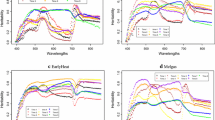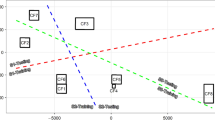Abstract
High resolution satellite imagery has the potential to map within-field variation in crop growth and yield. This study examined SPOT 5 satellite multispectral imagery for estimating grain sorghum yield. A 60 km × 60 km SPOT 5 scene and yield monitor data from three grain sorghum fields were recorded in south Texas. The satellite scene contained four spectral bands (green, red, near-infrared and mid-infrared) with a 10-m spatial resolution. Subsets were extracted from the scene that covered the three fields. Images with pixel sizes of 20 and 30 m were also generated from the individual field images to simulate coarser resolution satellite imagery. Vegetation indices and principal components were derived from the images at the three spatial resolutions. Grain yield was related to the vegetation indices, the four bands and the principal components for each field, and for all the fields combined. The effect of the mid-infrared band on estimates of yield was examined by comparing the regression results from all four bands with those from the other three bands. Statistical analysis showed that the 10-m, four-band image and the aggregated 20-m and 30-m images explained 68, 76 and 83%, respectively, of the variation in yield for all the fields combined. The coefficient of determination between yield and the imagery increased with pixel size because of the smoothing effect. The inclusion of the mid-infrared band slightly improved the R 2 values. These results indicate that high resolution SPOT 5 multispectral imagery can be a useful data source for determining within-field yield variation for crop management.


Similar content being viewed by others
References
Barnett, T. L., & Thompson, D. R. (1982). The use of large-area spectral data in wheat yield estimation. Remote Sensing of Environment, 12, 509–518. doi:10.1016/0034-4257(82)90025-6.
Batista, G. T., & Rudorff, B. F. T. (2003). Spectral response of soybeans by field radiometry. ISPRS Journal of Photogrammetry and Remote Sensing, 45(2), 111–121. doi:10.1016/0924-2716(90)90096-T.
Chang, J., Clay, D. E., Dalsted, K., Clay, S., & O’Neill, M. (2003). Corn (Zea mays L.) yield prediction using multispectral and multidate reflectance. Agronomy journal, 95, 1447–1453.
Dobermann, A., & Ping, J. L. (2004). Geostatistical integration of yield monitor data and remote sensing improves yield maps. Agronomy journal, 96, 285–297.
Goel, P. K., Prasher, S. O., Landry, J. A., Patel, R. M., Viau, A. A., & Miller, J. R. (2003). Estimation of crop biophysical parameters through airborne and field hyperspectral remote sensing. Transactions of the ASAE. American Society of Agricultural Engineers, 46(4), 1235–1246.
GopalaPillai, S., & Tian, L. (1999). In-field variability detection and spatial yield modeling for corn using digital aerial imaging. Transactions of the ASAE. American Society of Agricultural Engineers, 42(6), 1911–1920.
Huete, A. R. (1988). A soil adjusted vegetation index (SAVI). Remote Sensing of Environment, 25, 295–309. doi:10.1016/0034-4257(88)90106-X.
Inman, D., Khosla, R., Reich, R., & Westfall, D. G. (2008). Normalized difference vegetation index and soil color-based management zones in irrigated maize. Agronomy journal, 100, 60–66. doi:10.2134/agrojnl2007.0020.
Jordan, C. F. (1969). Derivation of leaf area index from quality of light on the forest floor. Ecology, 50, 663–666.
Ko, J., Maas, S. J., Mauget, S., Piccinni, G., & Wanjura, D. (2006). Modeling water-stressed cotton growth using within-season remote sensing data. Agronomy Journal, 98, 1600–1609. doi:10.2134/agronj2005.0284.
Leon, C. T., Shaw, D. R., Cox, M. S., Abshire, M. J., Ward, B., Wardlaw, M. C., et al. (2003). Utility of remote sensing in predicting crop and soil characteristics. Precision Agriculture, 4(4), 359–384. doi:10.1023/A:1026387830942.
Lobell, D. B., Ortiz-Monasterio, J. I., Asner, G. P., Naylor, R. L., & Falcon, W. P. (2005). Combining field surveys, remote sensing, and regression trees to understand yield variations in an irrigated wheat landscape. Agronomy Journal, 97, 241–249.
Plant, R. E., Munk, D. S., Roberts, B. R., Vargas, R. L., Rains, D. W., Travis, R. L., et al. (2000). Relationships between remotely sensed reflectance data and cotton growth and yield. Transactions of the ASAE. American Society of Agricultural Engineers, 43(3), 535–546.
Richardson, A. J., Heilman, M. D., & Escobar, D. E. (1990). Estimating grain sorghum yield from video and reflectance based PVI measurements at peak canopy development. International journal of imaging systems and technology, 16(3), 104–109.
Rouse J. W., Haas R. H., Shell J. A., Deering D. W. (1973). Monitoring vegetation systems in the great plains with ERTS-1. In Proceedings of third Earth resources technology satellite symposium, Vol. I, (pp. 309–317). Washington, DC: NASA.
Senay, G. B., Ward, A. D., Lyon, J. G., Fausey, N. R., & Nokes, S. E. (1998). Manipulation of high spatial resolution aircraft remote sensing data for use in site-specific farming. Transactions of the ASAE. American Society of Agricultural Engineers, 41(2), 489–495.
Shanahan, J. F., Schepers, J. S., Francis, D. D., Varvel, G. E., Wilhelm, W. W., Tringe, J. M., et al. (2001). Use of remote sensing imagery to estimate corn grain yield. Agronomy Journal, 93, 583–589.
Shi, Z., Ruecker, G. R., Mueller, M., Conrad, C., Ibragimov, N., Lamers, J. P. A., et al. (2007). Modeling of cotton yields in the Amu Darya River floodplains of Uzbekistan integrating multitemporal remote sensing and minimum field data. Agronomy Journal, 99, 1317–1326. doi:10.2134/agronj2006.0260.
Thenkabail, P. S., Smith, R. B., & De Pauw, E. (2000). Hyperspectral vegetation indices and their relationships with agricultural crop characteristics. Remote Sensing of Environment, 71, 158–182.
Thenkabail, P. S., Ward, A. D., & Lyon, J. G. (1995). Landsat-5 thermatic mapper models of soybean and corn crop characteristics. International Journal of Remote Sensing, 15, 49–61. doi:10.1080/01431169408954050.
Tomer, M. D., Anderson, J. L., & Lamb, J. A. (1997). Assessing corn yield and nitrogen uptake variability with digitized aerial infrared photographs. Photogrammetric Engineering & Remote Sensing, 63(3), 299–306.
Tucker, C. J., Holben, B. N., & Elgin, J. H., Jr. (1980). Relationship of spectral data to grain yield variation. Photogrammetric Engineering & Remote Sensing, 46(5), 657–666.
Vellidis, G., Tucker, M. A., Perry, C. D., Thomas, D. L., Wells, N., & Kvien, C. K. (2004). Predicting cotton lint yield maps from aerial photographs. Precision Agriculture, 5(6), 547–564. doi:10.1007/s11119-004-6342-5.
Wiegand, C. L., Rhoades, J. D., Escobar, D. E., & Everitt, J. H. (1994). Photographic and videographic observations for determining and mapping the response of cotton to soil salinity. Remote Sensing of Environment, 49, 212–223. doi:10.1016/0034-4257(94)90017-5.
Wiegand, C. L., Richardson, A. J., Escobar, D. E., & Gerbermann, A. H. (1991). Vegetation indices in crop assessments. Remote Sensing of Environment, 35, 105–119. doi:10.1016/0034-4257(91)90004-P.
Yang, C., & Anderson, G. L. (1999). Airborne videography to identify spatial plant growth variability for grain sorghum. Precision Agriculture, 1(1), 67–79. doi:10.1023/A:1009917617316.
Yang, C., & Everitt, J. H. (2002). Relationships between yield monitor data and airborne multidate multispectral digital imagery for grain sorghum. Precision Agriculture, 3(4), 373–388. doi:10.1023/A:1021544906167.
Yang, C., Everitt, J. H., & Bradford, J. M. (2002). Optimum time lag determination for yield monitoring with remotely sensed imagery. Transactions of the ASAE. American Society of Agricultural Engineers, 45(6), 1737–1745.
Yang, C., Everitt, J. H., & Bradford, J. M. (2006). Comparison of QuickBird satellite imagery and airborne imagery for mapping grain sorghum yield patterns. Precision Agriculture, 7(1), 33–44. doi:10.1007/s11119-005-6788-0.
Yang, C., Everitt, J. H., Bradford, J. M., & Murden, D. (2004). Airborne hyperspectral imagery and yield monitor data for mapping cotton yield variability. Precision Agriculture, 5(5), 445–461. doi:10.1007/s11119-004-5319-8.
Zarco-Tejada, P. J., Ustin, S. L., & Whiting, M. L. (2005). Temporal and spatial relationships between within-field yield variability in cotton and high-spatial hyperspectral remote sensing imagery. Agronomy Journal, 97, 641–653. doi:10.2134/agronj2003.0257.
Acknowledgments
We thank Jim Forward and Fred Gomez for GPS data collection and image rectification. Thanks are also extended to Ricky Durbin for use of his harvest equipment.
Author information
Authors and Affiliations
Corresponding author
Rights and permissions
About this article
Cite this article
Yang, C., Everitt, J.H. & Bradford, J.M. Evaluating high resolution SPOT 5 satellite imagery to estimate crop yield. Precision Agric 10, 292–303 (2009). https://doi.org/10.1007/s11119-009-9120-6
Received:
Accepted:
Published:
Issue Date:
DOI: https://doi.org/10.1007/s11119-009-9120-6




